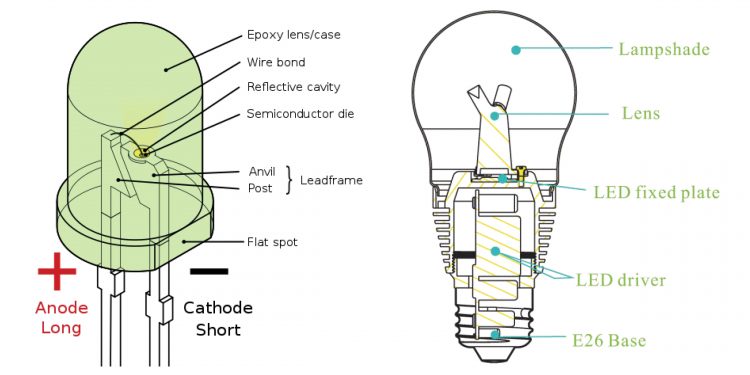Efficiency
LED lighting differs from traditional incandescent and fluorescent lighting in several ways, with the main difference being efficiency. LED lights use 25% to 80% less direct power than incandescent lights (typical light bulb) or fluorescent lights (tubular lights or bulbs) due to energy loss in their process. LED lights give off a small fraction of the heat that incandescent lights produce, making them safer in many instances. LED lights last much longer than either incandescent or fluorescent lights.
Incandescent bulbs produce light using electricity to heat a metal filament until it becomes white hot or is said to incandesce. As a result, incandescent bulbs release 90% of their energy as heat. Fluorescent lighting works by ionizing mercury vapor in a glass tube or globe causing electrons in the created gas to emit photons as UV frequencies and the UV light is converted to visible light using filtration through the phosphor coating on the inside. Incandescent and fluorescent lights shed efficiency by way of their process. These processes sound complicated, don’t they?
LED’s create light as electricity passes through the diode (semiconductor). All LED lights require DC power (think car battery) which must be transferred from our AC power sources via a transformer. Some larger LED lights (replacement light bulbs) have transformers or drivers built in. We offer a 12 V DC transformer in 1 amp or 5 amp capacity.
The electricity requirements are reduced significantly because the bulk of the electrical energy is being used to generate light. LEDs also emit light in a specific direction while incandescent and CFL light sources emit light and heat in all directions. That means LEDs are able to use light and energy more efficiently in a multitude of applications.

Lifespan
Another advantage that LEDs hold over traditional lighting is their increased lifespan which leads to lower overall replacement and maintenance costs.
Safety
LEDs are able to operate effectively on low-voltage electrical systems because they consume less power. Low-voltage electrical systems are safer in the event that something goes wrong. Additionally, LED lights give off a small fraction of the heat other light sources produce which can be a safety consideration in many situations.
Environmental
LEDs are environmentally safe compared to traditional lighting solutions which contain mercury internal to the bulb and tubes, and require special handling at the end of the product’s lifespan.
Design Flexibility
LEDs can be used in a number of different applications ranging from residential and commercial property applications to traffic signals, vehicle or boat lighting, and in aquariums. Because of their small size, they can be combined to form a traditional bulb, used in isolation, or strung in a sequence.
